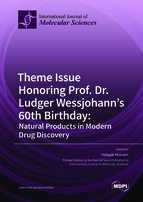Theme Issue Honoring Prof. Dr. Ludger Wessjohann’s 60th Birthday: Natural Products in Modern Drug Discovery
A special issue of International Journal of Molecular Sciences (ISSN 1422-0067). This special issue belongs to the section "Biochemistry".
Deadline for manuscript submissions: closed (31 October 2021) | Viewed by 53127
Special Issue Editor
Interests: synthetic chemistry; natural product chemistry; medicinal chemistry; bioorganic chemistry
Special Issues, Collections and Topics in MDPI journals
Special Issue Information
Dear Colleagues,
In 2021, Prof. Dr. Ludger Wessjohann, Professor and Director of Department Bioorganic Chemistry at Leibniz Institute of Plant Biochemistry, Halle, Germany has his 60th birthday. In recognition of his outstanding lifetime scientific contribution, we have arranged a Special Issue to which you are invited to submit a manuscript.
Prof. Dr Ludger A. Wessjohann
Director Dept. Bioorganic Chemistry
& Full Professor of Chemistry
Leibniz Institute of Plant Biochemistry (IPB)
Address: Weinberg 3, 06120 Halle (Saale), Germany
E-mail: wessjohann@ipb-halle.de
http://www.ipb-halle.de/en/research/bioorganic-chemistry/
Orcid: 0000-0003-2060-8235
Professor Wessjohann studied chemistry in Hamburg (Germany), Southampton (UK), and Oslo (Norway, Prof. Skattebøl). He earned his doctorate in 1990 with Prof. de Meijere in Hamburg. After a short period as lecturer in Brazil, he became a postdoctoral Feodor-Lynen fellow of the Alexander von Humboldt-foundation with Prof. Paul Wender at Stanford University (USA) working on the total synthesis of Taxol®. After an assistant professorship in Munich (LMU, 1992-1998), he was appointed to the Chair of Bioorganic Chemistry at the Vrije Universiteit Amsterdam (NL), working on organometallic chemistry and biocatalysis. Since 2001, he is director of the dept. of bioorganic chemistry at the Leibniz Institute of Plant Biochemistry (IPB) in Halle (Germany), and in parallel holds the chair of natural product chemistry of the Martin Luther-University Halle-Wittenberg. From 2010-2017 he served as the Managing Director of the IPB (www.ipb-halle.de).
Prof. Wessjohann focuses on the discovery, synthesis and application of natural products and bioactive derivatives thereof. He has over 400 publications, 30 patent applications, and is co-founder of six companies. He is member of many boards and commissions, including recently the “mision de sabios” of the Colombian government. He received numerous scholarships, prizes and honors, e.g. Microsoft IT Founders Award, and is a foreign member of the Brazilian Academy of Science.
Natural products (NPs) and their derivatives have historically made a major contribution to pharmacotherapy, in particular for cancer and infectious diseases. NPs are characterized by intriguing scaffold diversity along with structural complexity and because of this NPs continue to be an crucial source of leads for new medicines. Cancer is a world health issue and affects all communities around the globe regardless of religion, race or age. It is noteworthy that cancer is the second leading cause of death globally and is responsible for around 9.6 million deaths in 2018. Natural products (NPs) represent a tremendous resource for anticancer drug development along with treatment of other human diseases. Notably, about 80% of cancer therapy drugs approved by the United States Food and Drug Administration (FDA) during the last three decades are either NPs, NP derivatives, or mimicked NPs. Moreover 41% (646/1562) of all new drug approvals between 1981 and 2014 are NPs or derived from NPs. This illustrates that there is still an urgent need for the development of novel anti-cancer drugs with a unique mechanism of action.
This Special Issue welcomes original articles, communications and reviews dealing with the isolation and/or the investigation of mechanisms of action of natural products and their synthetic analogs with potential anti-cancer effects. In addition, this Special Issue also welcomes articles about the role of natural products and their derivatives to treat infectious diseases, microbial diseases, cardiovascular diseases and other human diseases. Finding target-identification (with biological assays together with computational studies), in vivo studies and the design of novel natural product derivatives with improved biological effects are also welcome.

Prof. Dr. Hidayat Hussain
Guest Editor
Manuscript Submission Information
Manuscripts should be submitted online at www.mdpi.com by registering and logging in to this website. Once you are registered, click here to go to the submission form. Manuscripts can be submitted until the deadline. All submissions that pass pre-check are peer-reviewed. Accepted papers will be published continuously in the journal (as soon as accepted) and will be listed together on the special issue website. Research articles, review articles as well as short communications are invited. For planned papers, a title and short abstract (about 100 words) can be sent to the Editorial Office for announcement on this website.
Submitted manuscripts should not have been published previously, nor be under consideration for publication elsewhere (except conference proceedings papers). All manuscripts are thoroughly refereed through a single-blind peer-review process. A guide for authors and other relevant information for submission of manuscripts is available on the Instructions for Authors page. International Journal of Molecular Sciences is an international peer-reviewed open access semimonthly journal published by MDPI.
Please visit the Instructions for Authors page before submitting a manuscript. There is an Article Processing Charge (APC) for publication in this open access journal. For details about the APC please see here. Submitted papers should be well formatted and use good English. Authors may use MDPI's English editing service prior to publication or during author revisions.
Keywords
- Drug Discovery
- Natural products
- Natural product derivatives
- Cancer
- Infectious diseases
- Microbial diseases
- Diabetes
- Cardiovascular diseases
- Human health
- Human diseases
- Computational methods
- In vitro studies
- In vivo studies
- Mechanism of action







